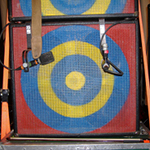Norman Lundin
New Work: Interiors/Landscape
Koplin Del Rio Gallery
6031 Washington Boulevard, Culver City, CA
March 7–April 11, 2009
Light is a primary subject of Norman Lundin’s recent paintings, but so is air, a matter much harder to depict. In these flattened, shallow realist interiors, Lundin, who has lived in Seattle since 1964, provides both spaciously. The warm brown window frames in Shoreline from the Boathouse Window and the doorjambs and floor planks in Room with an Electrical Cord, both 2009, begin rousing this ethereal atmosphere, but it’s the way that Lundin expertly paints the muddy grays and sullied whites of diffused light as it covers a room that transforms his formalist compositional exercises into something more ethereal.
The muted interiors of the late-nineteenth-century Danish painter Vilhelm Hammershøi, whom Lundin calls a major influence, certainly compare to these paintings, but so do Edward Hopper’s scenes of loneliness, despair, and alienation. Lundin, though, forgoes such modernist themes—as well as the human figure—as he constructs welcoming images of stillness, solitude, and contemplation. He tempers the stilted horizontals and verticals of Still Life for a Gray Afternoon, 2009, and The Music Room, 2008, with carefully arranged objects—glass jars, paint cans, ladders, and chair backs—that, as in a Giorgio Morandi still life, often lose their literal or symbolic purpose. What’s more, the otherworldly views outside windows are often blank, washed-out abstractions or reveal wintry non-places. A large blank wall framed like a cinema screen by two doors, baseboards, and wooden floors in Studio Corridor, 2008, exemplifies the kind of imaginary, airy, echoing space that a viewer can project into.
Originally published at Artforum.com on March 30, 2009.
